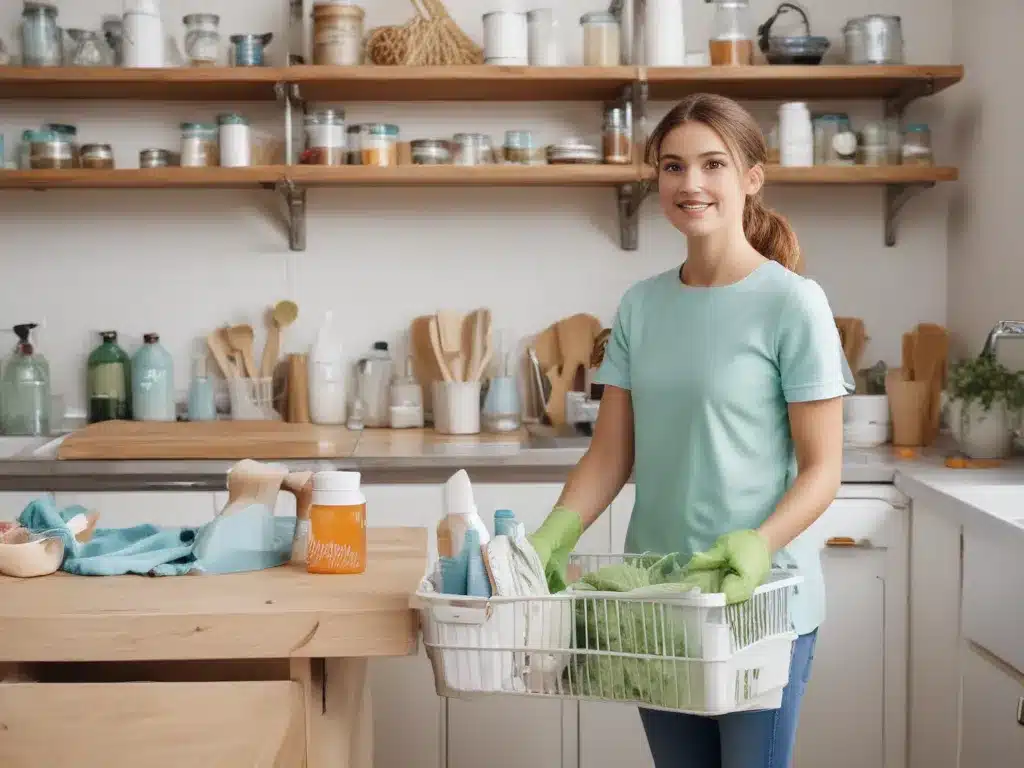Introduction
As a health-conscious individual, I understand the importance of maintaining a clean and organized living environment. However, many traditional cleaning products contain harsh chemicals that can be harmful to our health and the environment. That’s why I have made it my mission to find and share effective, non-toxic solutions for keeping our homes fresh, organized, and safe. In this comprehensive guide, I will share my top tips and tricks for creating a healthy, clutter-free home without relying on harmful chemicals.
Section 1: Non-Toxic Cleaning Solutions
H3: Natural Cleaning Products
When it comes to cleaning your home, there are numerous natural and non-toxic alternatives to harsh chemical cleaners. Here are some of my favorite natural cleaning products:
- Vinegar: Vinegar is a versatile and effective cleaning agent that can be used to clean surfaces, windows, and even remove stubborn stains.
- Baking Soda: Baking soda is a gentle abrasive that can be used for scrubbing and deodorizing.
- Essential Oils: Essential oils like lemon, tea tree, and eucalyptus have natural disinfecting and deodorizing properties.
- Castile Soap: Castile soap is a plant-based, biodegradable soap that can be used for a variety of cleaning tasks.
H3: DIY Cleaning Solutions
In addition to using natural cleaning products, you can also make your own DIY cleaning solutions. Here are a few simple recipes:
- All-Purpose Cleaner: Mix equal parts water and vinegar in a spray bottle. Add a few drops of essential oils for a pleasant scent.
- Glass Cleaner: Mix 1/4 cup of vinegar, 1/2 teaspoon of liquid soap, and 2 cups of water in a spray bottle.
- Tub and Tile Cleaner: Mix 1/2 cup of baking soda with a few tablespoons of liquid castile soap and water to form a paste.
H3: Green Cleaning Tips
To ensure a truly non-toxic cleaning routine, it’s important to adopt some eco-friendly practices:
- Use microfiber cloths: Microfiber cloths are highly effective at trapping dirt and bacteria, reducing the need for harsh chemicals.
- Opt for reusable cleaning tools: Invest in reusable cleaning tools like mops, scrub brushes, and sponges to reduce waste.
- Ventilate your home: Open windows and doors while cleaning to allow for proper air circulation and reduce exposure to fumes.
Section 2: Decluttering and Organization
H3: The Benefits of Decluttering
A cluttered living space can contribute to stress, anxiety, and even health issues. Decluttering your home not only creates a more visually appealing environment but also offers numerous benefits:
- Improved mental clarity: A decluttered space can help reduce mental clutter and improve focus.
- Enhanced productivity: With less clutter, you can find what you need more easily and eliminate distractions.
- Reduced allergens: Decluttering can help minimize dust, pet dander, and other allergens that can trigger respiratory issues.
H3: Decluttering Strategies
Decluttering can be a daunting task, but with the right strategies, it can be a manageable and even enjoyable process. Here are some effective decluttering techniques:
- The KonMari Method: Developed by Marie Kondo, this method involves keeping only items that “spark joy” and decluttering by category, not room.
- The One-In, One-Out Rule: For every new item you bring into your home, get rid of an old item.
- The 12-12-12 Challenge: Identify 12 items to throw away, 12 items to donate, and 12 items to keep.
H3: Organization Tips
Once you’ve decluttered, it’s essential to implement organizational systems to maintain a tidy and functional living space. Here are some helpful organization tips:
- Invest in storage solutions: Utilize storage bins, baskets, and shelves to keep items organized and out of sight.
- Label everything: Clearly label containers, drawers, and shelves to ensure easy identification and retrieval of items.
- Embrace vertical storage: Maximize space by utilizing vertical storage solutions like wall-mounted shelves or hanging organizers.
Section 3: Creating a Healthy Home Environment
H3: Indoor Air Quality
Poor indoor air quality can have a significant impact on our health, contributing to respiratory issues, headaches, and fatigue. To improve the air quality in your home, consider the following strategies:
- Use air purifiers: Air purifiers can help remove pollutants, allergens, and odors from the air.
- Increase ventilation: Open windows and use exhaust fans to promote air circulation and reduce indoor air pollution.
- Minimize harsh chemicals: Opt for natural cleaning products and avoid off-gassing from synthetic materials and paints.
H3: Eco-Friendly Pest Control
Traditional pesticides can be harmful to both human health and the environment. Instead, consider eco-friendly pest control methods:
- Natural repellents: Essential oils like peppermint, eucalyptus, and citronella can help deter common household pests.
- Exclusion techniques: Seal cracks, crevices, and entry points to prevent pests from entering your home.
- Biological control: Introduce natural predators like ladybugs or beneficial nematodes to control pests organically.
H3: Sustainable Living
Adopting a more sustainable lifestyle can not only benefit the environment but also contribute to a healthier home. Here are some sustainable living tips:
- Reduce, reuse, and recycle: Minimize waste by reducing consumption, reusing items, and properly recycling.
- Conserve energy: Implement energy-saving practices like using energy-efficient appliances and turning off lights when not in use.
- Support local and ethical brands: Choose products from companies that prioritize sustainability and ethical practices.
Conclusion
Creating a healthy and non-toxic home environment doesn’t have to be a daunting task. By embracing natural cleaning solutions, decluttering, and implementing sustainable practices, you can maintain a fresh, organized, and eco-friendly living space. Remember, small changes can make a big impact, and by prioritizing your health and the environment, you’ll be creating a safer and more enjoyable home for yourself and your loved ones.







